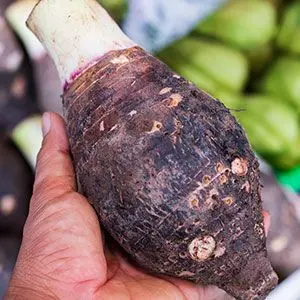Taro: Why This Root Is Causing a Stir Among Pet Owners
Popular in tropical places like Hawaii, this food can add an interesting texture to your pet's meals, but make sure you cook it properly. Because it's high in starch, only give it in small amounts. Here's how to share it with them.

STORY AT-A-GLANCE
- Taro is safe for pets to eat, as long as it’s thoroughly cooked and fed only in small quantities; however, it’s high in carbohydrates (starch), which dogs and cats have no biological need for
- Taro contains phytochemicals and polyphenolic compounds that may have beneficial effects. One example is anthocyanins, which are water-soluble pigments that have strong antioxidant and antiarteriosclerotic properties
- Quercetin is the main flavonoid found in taro; this polyphenol has a wide range of biological actions, such as antiviral, anti-inflammatory and anticarcinogenic effects
- Keep your pets away from the leaves, raw root and stems of the taro plant, as they contain calcium oxalates, which can be toxic to dogs and cats
- When feeding taro to your pets, make sure to cook it properly and serve it plain, without any seasonings
Editor's Note: This article is a reprint. It was originally published January 18, 2023.
There’s a lot of misinformation about healthy fruits, vegetables, nuts and seeds all over the internet, mostly because websites have labeled all risks (such as the risk of overconsumption causing gastrointestinal issues, or choking on too large of pieces or pits) as "toxicities." Not all of these are true yet they’ve managed to confuse millions of pet lovers, nonetheless.
In the case of feeding taro, many websites warn pet parents that feeding it to dogs and cats can cause severe adverse effects and poisoning. But are there truths to these claims? Here’s the real deal about taro, and whether or not it’s good for pets.
What Is Taro?
Also known as dasheen or eddo, taro (Colocasia esculenta) refers to an herbaceous plant that grows spherical, rootlike corms that are edible and used in breads, pudding and desserts. The corm, called taro root,1 is starchy and has a mild, slightly nutty flavor when cooked. Brown on the outside but white inside, the flavor is said to be similar to sweet potatoes.2 When added to meals, taro root absorbs other flavors easily.
So is taro safe for pets to eat? Yes, as long as it’s thoroughly cooked. However, it’s high in carbohydrates (starch), which dogs and cats have no biological need for. Hence, cooked taro can be added to your pet’s food but only in small amounts. It can add a layer of texture for your pets to enjoy.
Cooked Taro Is Safe, but Keep Pets Away from Taro Plants
The American Society for the Prevention of Cruelty to Animals (ASPCA) lists the taro plant, including the leaves, raw root and stems, as “toxic to dogs and cats” due to the insoluble calcium oxalates in them. This toxin can cause symptoms like excess drooling, oral irritation, vomiting, intense burning and difficulty swallowing in animals that come in contact with or accidentally ingest the raw root and other parts of the taro plant.3
The taro plant and its raw root also contain soluble oxalates, which can contribute to the formation of kidney and bladder stones.4 So if you have taro plants growing in your garden, make sure they’re in an area that is completely off limits to your pet. The good news is that when taro is cooked (even the leaves), these toxins are significantly reduced, making it safe to eat. Soaking the corms in a solution of baking soda and water for two hours prior to boiling can also help reduce these toxins.5
So, taro root should be thoroughly cooked before you include it in your pet’s food (or consume it yourself). If your pet is prone to developing urinary oxalate stones, it’s best to restrict the use of vegetables with high oxalate content, such as taro, to less than 2% of your homemade recipe ingredients, rotate recipes with low oxalate content and use low oxalate foods as treats.
Taro Trivia

Raw taro can cause irritation in humans, too. Bare contact with the mucilage from the raw taro corm can cause your skin to itch; never consume the raw corm and leaves either, because it will leave you with an itchy throat.6,7
Taro Contains Anthocyanins and Other Beneficial Compounds
An analysis8 conducted on taro found it contains phytochemicals and polyphenolic compounds that may have beneficial effects. One example is anthocyanins, which are water-soluble pigments with potent antioxidant and antiarteriosclerotic properties.9 Anthocyanins have also been found to possess anticancer activities, as they are toxic to cancer cells10 and may have a protective effect on your liver.11
One study demonstrated anthocyanins’ effects on the cognitive performance of elderly dogs. It found that dogs fed pet foods containing anthocyanins had a reduced cognitive dysfunction score and serum marker levels of amyloid-beta oligomers (the major toxic substance associated with Alzheimer’s disease) after 90 days. The researchers noted, “Our findings may support the neuroprotective effect of dietary anthocyanin in the central nervous system in elderly companion dogs.”12
Aside from anthocyanins, other compounds found in taro include flavonoids, which are free radical scavengers with strong anti-inflammatory effects, as well as alkaloids. Alkaloids are compounds that have biological effects on animals, thanks to their antimicrobial, antifungal, analgesic and anti-inflammatory properties.13
Top Taro Producers Worldwide

In 2019, Nigeria was the No. 1 taro producer, with 2,860,909 tons, or 27.14% of the global production. It was followed by Cameroon and China, with 18.12% and 18.11% of the global production respectively.14

Quercetin: Another Antioxidant Found in Taro
“Crops like taro contain flavonoids as well, and quercetin is the main flavonoid found in taro.”
This polyphenol has a wide range of biological actions, such as antiviral, anti-inflammatory and anticarcinogenic effects.15 In dogs, it’s been dubbed “Nature’s Benadryl” due to its potential to help ease allergies with its antihistamine effects.16
A 2019 study conducted on 15 canines also found that quercetin may have a protective effect during the early stages of sepsis, helping reduce the risk of liver and heart dysfunction. The researchers noted that this flavonoid may be even more effective than routine corticosteroid therapy.17
Despite Taro’s Beneficial Properties, It’s a High-Starch Food
The major caveat about taro root is that it’s a high-carbohydrate crop, with each corm containing up to 70% to 80% starch.18 As mentioned, dogs and cats have no biological need for starch, which is converted to sugar in their body. While dogs can tolerate a higher amount of dietary starch than kitties, it’s still a metabolic stressor for them, leading to a fluctuation in hormones. Excessive starch intake in pets puts their body into a pro-inflammatory state, as it increases their blood sugar levels.
One of the biggest reasons we are seeing an epidemic of metabolic and inflammatory diseases in pets is because of the unnaturally high amounts of starch, including those in processed pet foods, we’ve fed our pets over the last 50 years.
Calories from starchy foods like taro should make up less than 20% of the total calories consumed by your pet per day. So if you want to give this food to your pet, keep it to a minimal amount. There are also alternative options you can turn to (like squash) that provide similar health benefits without the burden of high amounts of starch.
Did You Know? GMO Taro Is Banned in Hawaii

In the U.S., one of the leading states that grows taro is Hawaii, producing 4.8 million pounds — a $6.4 million industry — in 2021.19 But in the early 2000s, this humble crop (called “kalo” in the state) was placed in the spotlight after natives expressed concerns about the risks of genetically engineering taro.
Genetic engineering was said to minimize the risk of diseases, for instance by making the plants resistant to leaf blight. While growing these hybrids could increase yields, consumers didn’t like the taste and the idea that their Hawaiian taro, a plant that is deeply ingrained in their culture, is being genetically transformed.
Hence, hundreds of consumers, lawmakers and farmers testified against GMO taro, saying, "We really don't know what the true effects will be, so until something is guaranteed, we no like."20 In 2009, the ban on GMO taro in Hawaii was finalized, banning the use and development of genetically modified organisms for Hawaiian taro varieties.21
How to Feed Taro to Your Pets
Taro is usually sold in grocery stores, especially Asian specialty stores. Make sure you always look for organic or spray-free varieties. If you see taro cut in half, inspect the flesh inside: it should have light purple specks. If the specks are brown, the taro is not good. Remember to wash the taro thoroughly under cold water as well, to remove any dirt clinging to it.22
When feeding taro to your pets, make sure to cook it properly and serve it plain, without any seasonings. Steaming and boiling are the best options. You can add small quantities to your pet’s nutritionally balanced, species-appropriate homemade diet, as a food topper. You can also mash it (mixed with other healthy foods, like squash, for example) and put it on a lick mat.
Cooked taro can be cut in small, bite-sized pieces then stuffed in an interactive toy. It can also be an ingredient in homemade training treats, keeping in mind that all healthy treats should make up less than 10% of your healthy pet’s daily caloric intake.
Sources and References
- 1 Britannica, Taro
- 2 My Vegan Minimalist, January 31, 2022
- 3 ASPCA, Taro
- 4 Livestock Research for Rural Development, 2020; 32(2)
- 5 Procedia Chemistry, 2014; 9: 102-112
- 6 Spoon University, June 11, 2014
- 7 Bioorg Med Chem Lett., 2015 Oct 15; 25(20): 4382-4386
- 8,11 International Journal of Research in Pharmacy and Pharmaceutical Sciences, May 2017; 2(3): 21-25
- 9 The Pharma Innovation Journal, 2021; 10(8): 1446-1451
- 10 J Agric Food Chem., 2014 March 21; 62(18): 3912-3918
- 12 Appl. Sci., 2022; 12(23): 12130
- 13 Alkaloids, November 13, 2019
- 14 ResearchGate, Top 10 Taro Producers in 2019
- 15 Nutrients, 2016 Mar; 8(3): 167
- 16 Dogs Naturally, August 29, 2023
- 17 Iranian Journal of Veterinary Medicine, October 2019; 13(4): 377-387
- 18 Cereal Chem., 69(5): 528-535
- 19 Taro Statistics, State of Hawaii, 2021
- 20 University of Montana, "Why Saving Hawaii's Taro Means Losing Hawaiian Taro," 2016
- 21 IATP, April 21, 2009
- 22 Full of Plants, "What Is Taro (And How to Cook It)," June 13, 2022











